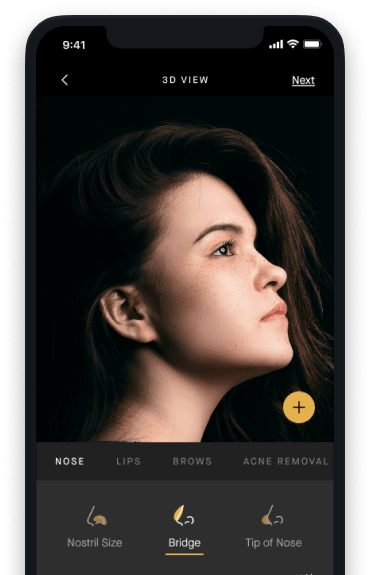 Even Skin Tone Solutions
Even Skin Tone SolutionsRosacea 101: Types, Triggers & Treatments
A Deep-Dive Into Managing This Complex Skin Condition
Our skin is often the first place we notice signs of aging; it can develop wrinkles and fine lines, changes in appearance and texture, or even start to feel looser or saggy. But that’s nothing new. What’s less commonly known is the fact that as we enter our mid-twenties, we’re also more susceptible to developing rosacea, an inflammatory skin condition that most commonly affects fair-skinned individuals aged 25 to 39.
While rosacea affects about 5% of the worldwide population (an estimated 415 million individuals), it’s rarely part of the skincare conversation. In fact, you might have it and not even realize it. Let’s break down what rosacea is, the symptoms to look out for, and a few ways to manage it effectively.
WHAT ARE THE DIFFERENT TYPES OF ROSACEA?
First, what is rosacea? Rosacea is a chronic skin condition that causes facial redness and visible blood vessels, sometimes with raised, pimple-like bumps. Researchers have yet to definitively determine the exact cause of rosacea, but family history (aka genetics) and environmental factors seem to both play a role. There are four main types of rosacea:
Erythematotelangiectatic Rosacea (ETR): usually the initial stage of rosacea, this subtype is marked by persistent facial redness that can easily be confused with a sunburn. Individuals with ETR might also experience flushing, visible blood vessels, and dry or sensitive skin.
Papulopustular Rosacea: often mistaken for acne, this subtype of rosacea has the same symptoms as ETR but with acne-like red bumps, with or without pus.
Phymatous Rosacea: primarily affecting the nose, phymatous rosacea causes the oil glands to enlarge and the hair follicles to dilate, resulting in noticeably bumpy skin. This type of rosacea can sometimes also affect the chin, forehead, or ears, and is more commonly seen among men.
Ocular Rosacea: The last type of rosacea differs because it doesn’t primarily affect the skin—it targets the eyes. Known as ocular rosacea, it typically causes redness, dryness, irritation, and, in some cases, swollen eyelids or blurred vision.
HOW CAN YOU TELL IF YOU HAVE ROSACEA VS. ACNE?
The truth is that you might not be able to tell the difference between rosacea and acne! Acne and rosacea symptoms can look pretty similar, especially if someone is experiencing papulopustular rosacea. If you think you might have rosacea, you should schedule a visit with your board-certified dermatologist to evaluate your skin condition. At your appointment, they’ll likely ask you a few questions about your family history with rosacea (i.e., does anyone in your family suffer from the condition?), how long you’ve had the redness, and if you’ve noticed any patterns around what makes your symptoms better or worse.
Rosacea tends to flare in response to triggers and is thought to be genetically linked, while acne is more tied to hormones and clogged pores. The doctor will also consider the location and features of any bumps. Rosacea only affects the face, and the bumps typically do not have any blackheads or whiteheads, unlike acne. It can be hard for an untrained eye to see the difference, but a skilled dermatologist will be able to diagnose fairly quickly.
CAN PREGNANCY CAUSE ROSACEA OR MAKE IT WORSE?
Yes, pregnancy can trigger or worsen rosacea because there are such extreme hormonal changes and fluctuations. But, a small 2023 study found that some women can actually see improvements in their skin condition during pregnancy. Not every medication for rosacea is considered safe during pregnancy, so women who are pregnant or trying to get pregnant should meet with their board-certified dermatologist to align on a safe rosacea treatment plan.
WHAT TRIGGERS ROSACEA FLARE-UPS?
A key part of managing rosacea relies on limiting potential triggers. While everybody responds differently, the National Rosacea Society suggests that certain foods, alcoholic beverages, skin care products, and medications can cause flare-ups along with extreme temperatures and stress (see full list here). According to a survey of 1,000 rosacea patients, the top five most common triggers are sun exposure, emotional stress, hot weather, wind, and heavy exercise.
WHAT ARE THE BEST OVER-THE-COUNTER PRODUCTS FOR ROSACEA?
To better understand how to treat each type of rosacea, and when it’s time to seek professional care, we spoke to AEDIT Founder and board-certified Head and Neck Surgeon, Dr. William Kennedy, for his expert insights:
Erythematotelangiectatic Rosacea (ETR): “For patients struggling with erythematotelangiectatic rosacea, I would typically recommend starting with gentle over-the-counter anti-inflammatory products for about 4 to 6 weeks. A fragrance-free cleanser, an anti-inflammatory moisturizer, and a product containing Azelaic Acid (10%) would be great options,” says Dr. Kennedy. “However, if the patient is experiencing consistent redness early on, I would advise moving directly into a topical prescription or Intense Pulsed Light Therapy (IPL) to help alleviate their symptoms.”
Papulopustular Rosacea: “When a patient is experiencing papulopustular rosacea, I typically recommend starting with an over-the-counter regimen. If inflammation and breakouts persist, then I often move to recommending topical treatments like metronidazole or ivermectin, both are designed to reduce inflammation and improve the microbial imbalance.”
Phymatous Rosacea: “For those dealing with phymatous rosacea, I would recommend bypassing the over-the-counter regimen and moving directly into prescription topical treatments. However, in extreme cases, I would recommend surgical or laser-based interventions like CO2 Laser to address the progressive tissue changes.”
Ocular Rosacea: “If you’re struggling with ocular rosacea, I would also recommend moving directly into prescription treatments. Since ocular rosacea affects the eyes and eyelids, I recommend early intervention with prescription drops or oral antibiotics to help manage symptoms.”
WHEN SHOULD YOU SEE A DERMATOLOGIST FOR ROSACEA?
The tricky thing about rosacea is that it’s easily confused with other conditions, like acne or sunburns. If you’ve noticed that your symptoms align with the characterizations of rosacea and are quite persistent, it’s time to make an appointment with your dermatologist. Unfortunately, rosacea does not go away on its own, so it will need to be managed under professional care.
ARE THERE PRESCRIPTION TREATMENTS OR IN-OFFICE PROCEDURES THAT HELP?
There are a number of rosacea skincare products, like prescription topicals and oral antibiotics, available today. Dr. Kennedy shared his insights on the most effective options:
"Depending on the subtype of rosacea and severity, I would typically recommend starting with a topical medication for mild to moderate cases, and if inflammation is more widespread, I would escalate to oral antibiotics. Each medication will target different aspects; therefore, choosing the right one is key.”
“The most recommended go-to for mild to moderate papulopustular rosacea is Azelaic Acid (15%). This topical treatment is an anti-inflammatory known for reducing redness and pustules with minimal irritation.”
“For a patient seeking long-term maintenance, I would suggest Metronidazole (0.75% or 1%). I typically recommend this topical treatment for sensitive skin types, as it’s especially effective in gently calming inflammation and reducing redness.”
“If a patient doesn’t see improvement after several weeks using Azelaic Acid or Metronidazole, I would typically escalate the treatment to Ivermectin, which is particularly effective for moderate to severe papulopustular rosacea.”
“I would recommend Winlevi for younger patients dealing with hormonal imbalances and oil production that are contributing to their rosacea. Although primarily prescribed for acne, Winlevi has been shown to improve the side effects of rosacea.”
“Oral antibiotics should be reserved for more severe cases when topical treatments haven’t been effective or a patient is seeking faster reduction in symptoms. I would generally prescribe Doxycycline as a low dose to reduce inflammation without the risk of bacterial resistance, which can be a long-term side effect.”
“Minocycline or Tetracycline would make great additional options for patients who don’t tolerate Doxycycline well. Both of these would be better reserved for stubborn or recurring flare-ups,” says Dr. William Kennedy.
Depending on the individual, dermatologists sometimes also recommend a few laser treatment sessions to minimize redness. “For patients struggling with persistent redness, especially erythematotelangiectatic rosacea, I often recommend Intense Pulsed Light (IPL); this treatment can offer broader improvements of overall redness and skin tone,” says Dr. Kennedy. “However, for patients struggling with phymatous rosacea, I would recommend the CO2 laser, best known for resurfacing skin and improving texture. Laser treatments are often considered cosmetic and, therefore, are not typically covered by insurance. Lastly, it is important to note that laser therapies are not permanent solutions, but rather tools to help manage symptoms.” While lasers can be effective, it’s important to note that they can be quite expensive and, unfortunately, are rarely covered by insurance.
IS ROSACEA CURABLE OR JUST MANAGEABLE?
Sadly, there is no cure for rosacea. That being said, there is a high success rate among patients in managing the condition. An experienced board-certified dermatologist can help prescribe or recommend the proper treatments, whether it be creams, oral medications, or laser therapy, while also helping to identify any lifestyle changes that could help minimize flare-ups.
CAN DIET OR LIFESTYLE IMPACT ROSACEA?
Diet and lifestyle can absolutely impact rosacea. There are a number of different rosacea causes and triggers. It’ll vary from person to person, but generally speaking, rosacea sufferers will want to limit alcohol consumption, skip foods classified as common triggers, use fragrance free skin products (note: this is different than unscented), manage stress, apply sunscreen regularly, and avoid extreme temperatures (e.g. hot baths, showers, or saunas).
HOW CAN I SOOTHE ROSACEA-PRONE SKIN NATURALLY?
If you’re having a rosacea flare-up, assess your diet and lifestyle to see if there are any potential triggers you can eliminate. From there, you can try natural remedies for rosacea, like applying products with ingredients that are known to have healing properties, like aloe, chamomile, green tea extract, or colloidal oatmeal. You can also try applying a cold compress or taking omega-3 fatty acid supplements (for ocular rosacea) to bring down any inflammation. While some of these natural remedies can be helpful, they don’t work for everyone. It’s best to work with your board-certified dermatologist to discuss how to treat rosacea naturally.
THE BOTTOM LINE
Rosacea is an inflammatory skin condition that can easily be confused with acne or even a sunburn. If you’ve noticed persistent facial redness, you’ll want to schedule a visit with your dermatologist right away. While there’s no current cure for rosacea, it can be managed with a combination of natural remedies, over-the-counter medications, prescription drugs, in-office laser therapy, and certain lifestyle or dietary changes.
tagsRosacea
More Related Articles
Related Procedures

AI Plastic Surgeon™
powered by'Try on' aesthetic procedures and instantly visualize possible results with The AI Plastic Surgeon, our patented 3D aesthetic simulator.

